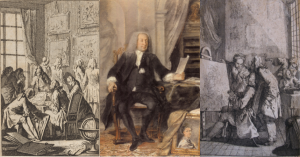The Artistic Taste of Nations: Contesting Geographies of European Art, 1550-1815

This conference will be held on 13 and 14 June 2019 at Vrije Universiteit Amsterdam. Researchers are invited to submit papers scrutinizing the impact of the early modern notion of ‘school’ on the emergence of a geographical understanding of the visual arts in Europe. As an organizing principle in art collections and art books, this notion was used to indicate a range of different kinds of places, including artists’ workshops, art academies, cities, regions and nations in Europe. Its application was far from standardized, however, as evidenced by the broad debates, negotiations and contestations amongst scholars, collectors, dealers, agents and artists concerning the nature, prestige and identity of art and artists. Depending on the contexts in which such debates took place (e.g. scholarship, collecting, the market or aesthetics), the notion of school could be associated with issues of taste and civilization, human variety and national character, nature and climate, and commerce or knowledge. The concept of school was thus based on the location of certain practices and modalities of art, although it was equally suited to the active shaping of ideas about the European art world and, possibly, even about the nations of Europe. The early modernconcept of school thus did not coincide with the modernnotion of national school. The extent to which it influenced modern forms of national-school classifications of art and national art history (which are currently under critical scrutiny by art historians with a geographical interest in the artistic exchange, transfer or circulation of early modern art) is open to debate (Gaehtgens 1993, Kaufmann 2004, Maës 2010).
Geographical notions of school were widely adopted in both art books and art collections in early modern Europe. For example, in the art literature, Giorgio Vasari (1550/1568) referred only to schools of artists, even though he perceived differences between the production of art in Florence and Venice. Giovanni Battista Agucchi (c. 1607-15) was apparently the first to distinguish between schools of Italian painting (i.e. Roman, Venetian, Lombard and Tuscan). In the same period Karel van Mander (1604) took the geographic origins of artists – which now included the Low Countries and Germany in addition to Italy – as an organizing principle for their biographical compendia. This was also done later by Joachim von Sandrart (1675-80). With the notion of the ‘taste of nations’, Roger de Piles (1699) created a systematic connection between schools and nations, while securing a place for French art and artists on the European map of art. Similarly, geographical arrangements have appeared in collections from early times. In some cases, they were used in encyclopaedic collections, which usually tended to follow a thematic order and included objects from outside of Europe. They became predominant in print and drawing collections assembled by Basilius Amerbach (1533-1591), Louis Odespung de la Meschinière (1597-1655), Filippo Baldinucci (1624-97), Pierre Crozat (1661-1740), Heinrich von Heinecken (1707-91), Pieter Cornelis van Leyden (1717-88) and others. As it seems, geographical arrangements of art were systematized in paper collections even before they were adopted in picture galleries (e.g. in Düsseldorf, Dresden, Vienna, Florence and Paris).
Of special interest for this conference – and the planned publication of its proceedings – are case studies devoted to art collections and art literature, as well as the often-close connections between them. Case studies of collections may comprise those of an encyclopaedic nature, as well as those devoted to prints, drawings or paintings. Several approaches are considered particularly relevant to the geographical analyses of the case studies. First, the conceptual approach to the art-geographical notion of school, which has come to imply places of artistic tuition and modalities of art, as well as publics of art, as it became tied to the notion of nation (Peltre/ Lorentz 2007, Brunner/Koselleck 1972-97, Leerssen 2006). Second, the rise of art connoisseurship supplied an instrument for evaluating art works, artists and schools in Europe through mutual comparison and critical assessment (Griener 2010, Michel 2014, Smentek 2014). Third, the aspect of trans-local, trans-regional and/or trans-national networks has shaped geographies of art through travel, debate, correspondence, trade or agency in various parts of Europe (Meyer/ Savoy 2014, Keblusek 2011).
Papersmay focus on but need not be limited to:
– collections of prints, drawings, paintings or other art works, including within the context of encyclopaedic collections;
– works of art literature in the widest sense of the term;
– geographical arrangement as a form of mapping European art;
– trans-local, trans-regional or trans-national discourses of art;
– the concepts of art, school and nation, as well as the connections between them;
– identity formationthrough artistic concepts of school, character, style or taste;
– European networks of collectors, curators, scholars, dealers and artists;
– increasing public access to collections and/or museums;
– the rise of art connoisseurship and the critical evaluation of art;
– values of art on the market;
– the early-modern roots of modern national (and nationalistic) histories of art.
Proposals for papers should be submitted before 15 November 2018 (i.r.vermeulen@vu.nl). They should contain an abstract of no more than 300 words, as well as a brief biography (no more than 200 words). The conference will be held on 13 and 14 June 2019 at Vrije Universiteit Amsterdam. The costs of travel and accommodation will be covered for researchers whose proposals are selected. The conference is made possible by a fund from the Netherlands Organisation for Scientific Research (NWO), and it is realized in cooperation with the Rijksmuseum Amsterdam and the Interfaculty Research Institute for Culture, Cognition, History and Heritage (CLUE+) of Vrije Universiteit Amsterdam.
Concept and organization: Ingrid Vermeulen and Huigen Leeflang
Scientific committee: Ingrid Vermeulen, Frans Grijzenhout, Everhard Korthals-Altes, Huigen Leeflang, Joep Leerssen, Debora Meijers, Véronique Meyer, Arnold Witte.

Leave a Reply
You must be logged in to post a comment.